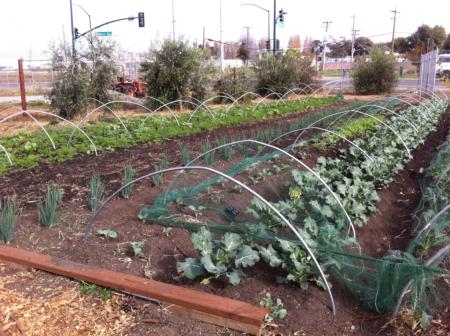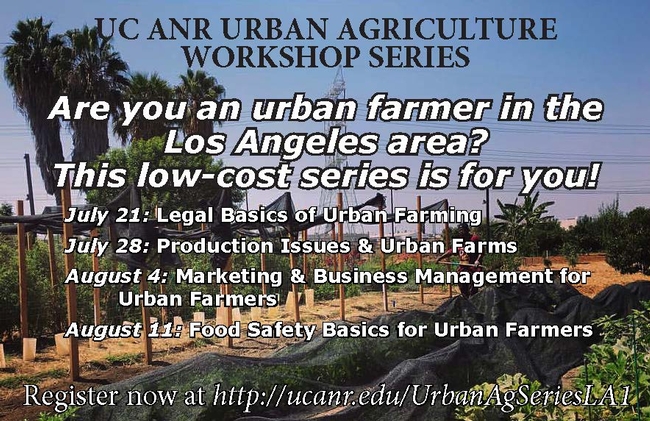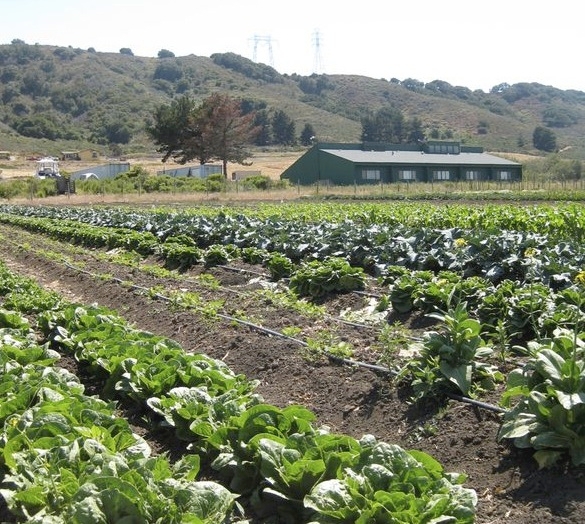Posts Tagged: Local Food
UC ANR hosts workshops for California's urban farmers

Building on the needs assessment, a team of UC ANR researchers created a resource website for California urban farmers. This year, team members and local partners are conducting a series of trainings for urban farmers around the state, designed to help city growers build their knowledge in key areas. The series just wrapped up in the Bay Area, and will roll out in Los Angeles starting on July 21. The Los Angeles series dates and topics are:
- July 21. Legal Basics of Urban Farming. Are you an urban farmer navigating the rules and regulations related to growing and selling food? A school or non-profit organization involved in farming? This workshop will help position you for success.
- July 28. Production Issues and Urban Farms. Are you an urban farmer learning the ins and outs of growing and harvesting crops? This workshop is designed to guide urban farmers through common production challenges related to soil, water use, and pest management.
- August 4. Marketing and Business Management for Urban Farmers. From business planning to labor laws, learn the basics to help you succeed.
- August 11. Food Safety Basics for Urban Farmers. Learn how to ensure a safe harvest, from the field to the fork.
Local partners are key to planning and hosting these events, including the Los Angeles Food Policy Council, the Collaborative for Urban Agroecology Los Angeles, Cal Poly Pomona College of Agriculture, Community Services Unlimited, GrowGood, the Growing Experience, and others.
The series will also be held in Sacramento and San Diego in early 2018. For updates and announcements, follow UC ANR's Urban Agriculture blog, Facebook, and Twitter. And be sure to bookmark our UC Urban Agriculture website which offers resources on production, policies, and more.

Urban Ag Workshop Series-SoCal 5-23-17A (3)
Farmers learn, connect, tour and taste in Sacramento
Running a small-scale farm or ranch isn't easy; it requires hard-learned skills, innovative marketing and a supportive community. Farmers and ranchers from all over California will join with farmers' market managers, educators, small farm advocates, and some of the most creative of Sacramento's Farm to Fork chefs at the California Small Farm Conference, held this year at the DoubleTree Hotel in Sacramento from March 5 to March 8, 2016.
For three days, about 400 attendees will join workshops, explore with field courses, network with colleagues and enjoy a few social events. The now-annual conference was started by the UC Agriculture and Natural Resources (UC ANR) Small Farm Program in 1982 as a unique opportunity for small-scale farmers to learn, network and grow their businesses. UC ANR specialists, advisors and staff continue to contribute to the conference as members of the board of directors and as educators presenting science-based information at workshops and field courses.

Sunday, March 6, features all-day field courses and short courses, giving participants a chance for deeper understanding and multiple perspectives as they explore their choice of four different topics. Two of the courses this year will be led by UC ANR educators or staff.
For the on-site short course, "Starting a SUCCESSFUL Specialty Food Business," Shermain Hardesty, a UCCE specialist in the Department of Agricultural and Resource Economics at UC Davis (and leader of the UC Small Farm Program) teams up with Linda Harris, a UCCE specialist in Food Safety and Microbiology at UC Davis, Dan Sullivan, a specialty food business expert and specialty food producers, Jason Poole of Preservation & Co. and Courtney Smith of Bloomingcamp Ranch. UCCE Agritourism Coordinator Penny Leff will lead a field course named, "Direct Marketing: Farmers' Markets, Farm Stands, U-Pick and Wine Tasting," that will visit and learn from some of Sacramento region's expert practitioners of these various direct marketing venues.
Sacramento region food and beverage fans are invited to attend the "Taste of Sacramento" Tasting Reception on Monday, March 7, from 5:30 to 7:30 p.m. The Tasting Reception is the culinary and social highlight of the California 
Online registration for the conference has now closed, but on-site registration is welcome! For more information, see the California Small Farm Conference website, or phone (888) 712-4188. See you there!

Photo of Guido Frosini, True Grass Farms, by Janae Lloyd, a winner of the farm conference 2015 photo contest.
UC Davis tomatoes provide year-round healthful eating for college students

At the same time, chefs and food buyers at universities, particularly the University of California, are selecting for high-quality fruits and vegetables, produced locally and sustainably. Universities with strong food sustainability programs are rightfully proud of what they're doing to educate students about food production, health, and nutrition. UC Davis Dining Services prioritizes the purchase of locally grown food (ideally within a 50-mile radius of campus). Most University of California campuses have similar programs.
At UC Davis, fresh roma tomatoes are picked each August from the 300-acre Russell Ranch, part of the campus's Agricultural Sustainability Institute, then processed within hours by campus Dining Services to provide year-round tomato sauce for pizza, pasta, and ratatouille. All told, 10,000 pounds of tomatoes are processed during a two-week period in August. About 29 percent of the total food served in the campus's residential dining halls is from local, organic or sustainable sources.

Emma Torbert, an academic coordinator at the UC Davis Agricultural Sustainability Institute, noted, “Connecting the food system to the research is really interesting. A lot of times there is confusion about where our food is coming from. The more people are educated, the more educated decisions they can make.”
Many UC Davis faculty and staff are so impressed with the food choices at the dorms that they purchase individual meal tickets and enjoy lunches made with the campus-grown tomatoes, herbs, and other vegetables, all of which are part of the daily food array. Public dinners are also offered periodically at the dorms so that community members can sit amongst students to taste and learn about the sustainability programs in the dorms.
Additional Information:
- Video: Farm to Table, UC Davis Tomatoes; 2010
- Slide show of this year's UC Davis tomato harvesting and processing system; 2014
- Sustainable Foodservice Progress Report 2014, UC Davis Dining Services
- Two videos of UC Davis students who work at the Student Farm to produce food, including one on tomato sauce production
- “Tomatoes: Safe methods to store, preserve, and enjoy.” UC Agriculture and Natural Resources, free publication
San Luis Obispo County local food roots are strong, can support growth

A new report assessing San Luis Obispo County's food system links the vitality of the county's agriculture with the health of its residents and its food businesses.
Conducted by the UC Sustainable Agriculture Research and Education Program (UC SAREP) and Central Coast Grown (CCG), the San Luis Obispo County Food System Assessment examines the relationships between agriculture, regional environmental quality, human health and local livelihoods.
“We found that the county food system in San Luis Obispo is thriving with increased agricultural sales and school districts beginning to participate in garden-based education,” says Jenna Smith, executive director of Central Coast Grown. “But there are many opportunities for improvement. With excitement building around local food and improved nutrition, it's vital for a county to see an honest accounting of where it stands in those arenas.”
In 2007, farmers in San Luis Obispo County sold agricultural products valued at $4.3 million directly to consumers, an increase from previous years. The report suggests that continued promotion of local and direct marketing of food can assist all producers, including new farmers, in entering the marketplace and bolstering the local food system overall.
Those markets will be especially important as the number of farmers in the county grows. In 2007, there were 850 more agricultural producers than 10 years prior. But the majority of farms in 2007 reported gross sales of under $250,000 per year, with nearly half of all farms in the county reporting less than $5,000 in annual sales.
“Unfortunately, we have little information available to define who these small-scale farmers are, what they are growing, how they impact local employment, and how they might interact with the local food system,” said Mary Bianchi, director of UC Cooperative Extension in San Luis Obispo County, who advised on the report. “We need a better understanding of what these farmers produce, and how they can better participate in the local food economy.”

In a parallel survey conducted by Central Coast Grown, they asked farmers and restaurant owners about the challenges to selling and buying locally.
“Our survey reinforced the findings of the SLO Food System Assessment,” says CCG director Smith. “Both farmers and restaurant owners reported a need and value for localized distribution channels.”
The report also addresses access to healthy food as a component of the county's food system. Participation in food assistance programs like CalFresh and food distributed by food banks in San Luis Obispo County have both increased over the last decade, though overall food insecurity in the county has improved marginally.
While increases in food distribution may mean those outlets are accessing more people, it also means more people are in need of the assistance.
Beyond continued support from government food programs, the report recommends ways that increasing food access for the public and improving markets for local producers can reinforce one another. Food-focused community development strategies such as mobile markets, community farms, and farm-to-school bring agriculture into neighborhoods and schools and help close the gap between producers and consumers.

San Luis Obispo County also faces water quality and water quantity challenges that are echoed throughout the state. Nitrate contamination from both urban and agricultural sources affects local lakes, rivers and streams. Groundwater and coastal stream resources both present significant challenges for agriculture and rural communities dependent on them for drinking water.
“Accounting for those concerns within the context of the entire food system may bring a broader scope to the discussion along with the potential to leverage the efforts of the many groups already working on water resources issues,” Bianchi said.
The Food System Assessment was conducted in partnership with the San Luis Obispo County Food System Coalition. Coalition meetings are held quarterly to discuss local food system issues and are open to the community. The report was funded by the California Department of Food and Agriculture which also supports Central Coast Grown's upcoming release of a Public Land Survey that identifies underutilized agriculturally viable land county-wide.
The report is available on the UC SAREP and Central Coast Grown websites.
Farm to fork, and all that's in between
* - Updated 8/6/2012
As the local food movement scales up and consumers demand information about where their food comes from, more grocers and institutions are seeking wholesale access to local produce. To make the connection between producers and retail sellers, distribution networks are taking on an increasingly important role in the local food system. More and more, farmers are becoming part of values-based supply chains and ‘food hubs’ to pool their product with that of other farmers and move food more easily to market and complete the chain from farm to fork (*).
New reports released by the UC Sustainable Agriculture Research and Education Program (SAREP) show that, while food hubs help close the gap in distribution efforts, farmers should invest carefully. UC SAREP has created a Farmer Toolkit for those interested in taking part in a food hub.
“We wanted to suggest some questions farmers should consider before getting involved with an enterprise,” said Gail Feenstra, academic coordinator at UC SAREP (*).

“When food hubs are working,” Feenstra said, “the farmer gets a higher price for their product, and everybody along the supply chain benefits. Consumers get the satisfaction of knowing where their food comes from, and the food is good quality” (*).
But the challenges of food hubs are steep. While food hubs often succeed at keeping the social and environmental values of their products front and center (that they are organic, local, or grown by family farmers, to name a few values), business plans for long-term success are not always part of the planning process (*).
Traditional distribution centers that have been the standard in produce distribution are incredibly well established compared to young food hubs. In researching existing distribution networks, “we found that there are really long-standing partnerships amongst distributors,” says Feenstra. “They go back decades and generations.”
For farmers looking to keep their social and environmental values embedded in their products, abandoning traditional distribution networks may not be the way to succeed. Rather, “creative partnerships between conventional players and more alternative folks may be a better model. In cases where you can create cooperative of growers in which they own the process and they’ve got good management, it’s a slow build up, it can’t happen overnight. But they can succeed,” Feenstra said.
The farmer toolkit is meant to give farmers a better sense of how to make that success happen and how to bring the value of sustainably produced food into the supply chain.
The farmer toolkit and more information on values-based supply chains can be found at the UC SAREP Web site.
Farmer Toolkit
